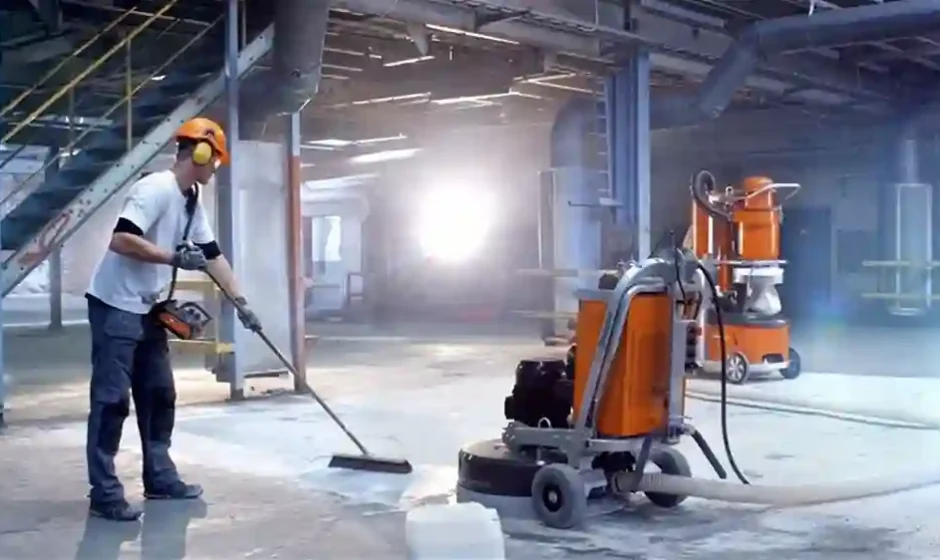Concrete floor grinding is an essential technique in modern construction, offering a blend of functionality and aesthetics that is particularly valued in Australian building projects. In this article, we will explore in detail what concrete floor grinding is, when it should be applied during the building process, and the benefits and challenges associated with it. Drawing on industry practices and the unique requirements of the Australian construction environment, this guide provides a clear understanding of how to effectively incorporate concrete floor grinding into your projects.
What is Concrete Floor Grinding?
Concrete floor grinding involves the mechanical removal of imperfections from a concrete surface using specialised grinding machines fitted with diamond abrasive tools. This process smooths the surface by eliminating high spots, contaminants, and unwanted coatings, thereby creating a level substrate that is ideal for subsequent floor treatments.
The process typically includes multiple stages:
- Rough Grinding: The first pass removes thick coatings, adhesives, and irregularities.
- Intermediate Grinding: This step further refines the surface, eliminating any remaining unevenness.
- Polishing: Often used when a high-gloss finish is desired, polishing uses progressively finer abrasives to achieve a mirror-like surface.
In Australia, where the construction climate can range from the coastal humidity of Queensland to the dry outback conditions, ensuring that a concrete floor is correctly prepared is critical. Grinding not only improves the surface’s appearance but also prepares it for a variety of floor treatments, such as epoxy coatings, sealers, or even polished concrete finishes that require precise substrate conditions.
When to Use Concrete Floor Grinding
Deciding when to use concrete floor grinding in your project depends on several factors. Here, we break down common scenarios in the building process where this technique is most beneficial:
1. New Construction Projects
In many new builds, especially those involving commercial or industrial facilities, the freshly poured concrete often contains minor imperfections such as uneven spots, air bubbles, or trowel marks. Using concrete floor grinding:
- Improves Surface Uniformity: Grinding helps create a smooth, even surface that enhances the appearance of the finished floor and ensures that any subsequent coatings or treatments adhere properly.
- Enhances Durability: By removing surface inconsistencies, the risk of premature wear and tear is reduced. This is particularly important in high-traffic areas like warehouses, factories, and retail spaces.
- Prepares for Overlays: When planning to apply epoxy coatings, self-leveling compounds, or decorative finishes, a ground surface provides a better bonding base, reducing the likelihood of peeling or delamination.
2. Renovation and Refurbishment Projects
Older buildings or facilities often need refurbishment to meet modern standards. In these scenarios, concrete floor grinding can be invaluable:
- Removing Old Coatings: Over time, concrete surfaces might be covered with old paints, sealers, or adhesives that have deteriorated. Grinding effectively removes these layers, exposing a fresh substrate.
- Repairing Damaged Surfaces: For surfaces with minor cracks or surface wear, grinding can help level out the damage, making it easier to apply repairs or new finishes.
- Upgrading Aesthetics: Many renovation projects aim to modernise the appearance of the facility. A polished concrete finish achieved through grinding can transform an outdated floor into a sleek, contemporary surface.
3. Industrial and Commercial Facilities
Industries and commercial establishments often require floors that can withstand heavy use and abuse. In these cases, concrete floor grinding is used:
- To Improve Safety: A uniformly ground floor reduces the risk of trips and falls, an important consideration in busy industrial environments.
- For Chemical Resistance: In areas where chemical spills are a risk, a properly prepared surface allows for the application of specialised chemical-resistant coatings.
- To Increase Productivity: A smooth floor can be easier to clean and maintain, which is critical in industries where cleanliness is paramount, such as food processing and pharmaceuticals.
4. Residential Applications
While industrial and commercial applications are more common, residential projects can also benefit from concrete floor grinding:
- Creating Modern Living Spaces: Open-plan living areas and contemporary homes often feature polished concrete floors as a design element. Grinding helps achieve the desired smooth finish.
- Cost-Effective Renovations: For homeowners looking to upgrade without a full-scale demolition, grinding provides a cost-effective solution to refresh and renew concrete surfaces.
- Improving Indoor Air Quality: By eliminating dust and contaminants from older coatings, grinding can also contribute to better indoor air quality—a growing concern in many Australian households.
The Benefits of Concrete Floor Grinding
The benefits of integrating concrete floor grinding into your building process are numerous, and they extend from the practical to the aesthetic. Here are some key advantages:
Enhanced Surface Preparation
A ground surface is ideal for the application of various floor finishes. Whether you’re installing a decorative overlay or applying a protective sealer, the quality of the bond between the substrate and the finish is crucial. Grinding removes impurities and creates a roughened profile that increases adhesion, thereby enhancing the longevity of the applied finish.
Cost Savings and Efficiency
Investing in concrete floor grinding can lead to significant cost savings over time. By addressing surface imperfections early, you avoid the need for more extensive repairs or premature replacement of floor finishes. Additionally, a well-ground surface can reduce the amount of material required for overlays, making the process more economical.
Improved Aesthetic Appeal
In today’s competitive market, the appearance of a building can make a big difference. A polished concrete floor, achieved through careful grinding, provides a sleek, modern look that appeals to both commercial clients and homeowners. The reflective quality of a polished surface can also enhance lighting conditions, creating a brighter, more inviting space.
Environmental Considerations
Concrete floor grinding is a sustainable option in many cases. By refurbishing and reusing existing concrete rather than replacing it entirely, you can reduce waste and lower the environmental impact of your project. Moreover, modern grinding equipment often includes dust extraction systems that minimise airborne particulates, thereby reducing environmental and health risks on site.
Considerations Specific to the Australian Market
When planning concrete floor grinding projects in Australia, there are a few region-specific factors to consider:
Climate and Environmental Conditions
Australia’s diverse climate means that the choice of grinding techniques and subsequent floor finishes must be adapted to local conditions. In tropical regions, high humidity and temperature fluctuations can affect the curing and performance of floor coatings. In contrast, in drier regions, dust control and moisture retention become significant issues. It’s crucial to select the right equipment and materials to withstand these local conditions.
Compliance with Standards and Regulations
Australian construction projects are subject to strict building codes and standards, which typically include specific requirements for floor preparation and finishing. It is essential to ensure that any grinding work complies with these regulations to avoid delays and additional costs. Engaging with professionals who understand both the technical and regulatory aspects of floor grinding is highly advisable.
Workforce Skills and Equipment Availability
The success of a concrete floor grinding project depends on the expertise of the workforce and the availability of suitable equipment. In Australia, there is a growing number of specialised contractors who focus on surface preparation, offering a range of services from rough grinding to high-gloss polishing. Choosing a contractor with local experience and a proven track record ensures that the job is completed safely, efficiently, and to a high standard.
Techniques and Equipment in Concrete Floor Grinding
Several techniques and pieces of equipment are used during the concrete floor grinding process. Understanding these can help you determine the best approach for your project.
Diamond Grinding Machines
At the heart of the process are the diamond grinding machines. These machines use diamond-impregnated discs or pads that rotate at high speed, grinding away imperfections in the concrete surface. The quality and size of the diamond segments vary depending on the hardness of the concrete and the level of finish required.
Dust Extraction Systems
Dust control is a major consideration in concrete grinding. Modern machines are equipped with integrated dust extraction systems that capture the majority of the dust produced. This not only creates a safer working environment but also minimises clean-up time and reduces the environmental impact of the project.
Handheld Grinders and Scarifiers
For smaller or more intricate areas, handheld grinders or scarifiers may be used. These tools allow for precision work in areas where large machines cannot reach, such as corners, edges, or areas around embedded fixtures. While they are less efficient for large areas, they are indispensable for achieving a uniformly smooth finish in detailed spaces.
When Not to Use Concrete Floor Grinding
While the advantages of concrete floor grinding are clear, it is not always the best option. There are circumstances where alternative methods might be more appropriate:
Severely Damaged or Weak Concrete
If the concrete is extensively cracked, spalled, or structurally unsound, grinding may do more harm than good. In these cases, the underlying issue must be addressed through repair or replacement. Grinding over a compromised substrate can exacerbate existing damage and lead to costly failures down the line.
Presence of Hazardous Materials
In some renovation projects, especially in older industrial buildings, the concrete may be contaminated with hazardous materials such as asbestos or lead-based paints. In such situations, specialised remediation processes must be followed, and conventional grinding should be avoided until the contaminants have been safely removed.
Excessive Time Constraints
Concrete floor grinding is a process that requires careful planning and execution. Rushing the process can result in an uneven finish or incomplete removal of coatings, leading to additional work and increased costs. If the project timeline is extremely tight, alternative fast-track methods such as shot blasting might be considered, though these too have limitations.
Best Practices for Implementing Concrete Floor Grinding
To achieve optimal results with concrete floor grinding, consider the following best practices:
- Engage Experienced Professionals: Ensure that the team you hire has a proven track record with concrete grinding projects in the local market. Their experience will be invaluable in troubleshooting on-site challenges.
- Conduct a Thorough Assessment: Before starting any grinding work, carry out a detailed inspection of the concrete surface to identify imperfections, contaminants, and potential hazards.
- Plan for Dust Control: Invest in equipment with high-quality dust extraction systems and ensure that proper measures are in place to protect both workers and the surrounding environment.
- Choose the Right Equipment: The selection of the appropriate machinery—whether large-scale grinders or handheld devices—depends on the specific requirements of the job. Tailor your approach to the size and complexity of the area.
- Follow Safety Protocols: Grinding concrete produces fine dust and debris that can pose health risks. Ensure that all safety regulations are followed, including the use of personal protective equipment (PPE) such as masks, goggles, and hearing protection.
- Integrate with Other Processes: Consider how the grinding phase will fit into the overall construction timeline. Proper coordination with subsequent processes like sealing or overlay installation is crucial for ensuring a durable and attractive finish.
Real-World Applications and Case Studies
To better illustrate when concrete floor grinding should be used, consider the following examples from Australian projects:
Commercial Office Building Renovation
In a recent refurbishment of a commercial office building in Melbourne, the client aimed to modernise the workspace without a complete floor replacement. The existing concrete floors, although structurally sound, were marred by years of wear, old adhesive residues, and minor surface imperfections. By employing a multi-stage concrete floor grinding process, the contractor was able to remove old coatings and level the surface. This prepared the floor for a high-quality epoxy overlay, resulting in a modern, durable, and visually appealing surface that met both functional and aesthetic requirements.
Industrial Warehouse Upgrade
A large industrial warehouse in Brisbane required a floor upgrade to support heavy machinery and high-traffic logistics operations. The original concrete floor had significant unevenness and areas of localised damage due to constant use. Through thorough grinding and surface preparation, the contractor was able to remove imperfections and create a uniform substrate. This allowed for the application of a specialised, high-performance coating designed to withstand heavy loads and chemical spills. The end result was a resilient, safe, and long-lasting surface that improved operational efficiency and reduced maintenance costs.
Residential Modernisation Project
In a high-end residential development on the Gold Coast, homeowners sought a contemporary design that featured polished concrete flooring in the living areas. The existing concrete, while structurally sound, did not possess the visual appeal required for a modern home. A detailed grinding process was employed to remove imperfections and expose a smooth, even surface. Following the grinding, a series of polishing passes were undertaken to achieve a reflective, high-gloss finish. The transformation was dramatic, with the newly polished floors contributing significantly to the overall modern aesthetic of the home.
A Highly Effective Solution
Concrete floor grinding is a versatile and highly effective process that plays a critical role in the building process across Australia. Whether in new construction, renovation, industrial, commercial, or residential applications, the process can transform a rough, imperfect concrete surface into a smooth, attractive, and durable foundation for further treatments. Its benefits include improved surface uniformity, enhanced adhesion for coatings, long-term durability, and aesthetic appeal.
However, as with any construction process, it is important to recognise when grinding is appropriate and when alternative methods may be preferable. Factors such as the condition of the existing concrete, the presence of hazardous materials, and the overall project timeline must all be carefully considered. By engaging experienced professionals, selecting the right equipment, and following best practices, builders can ensure that concrete floor grinding is applied effectively, contributing to a successful and cost-efficient project.
In summary, concrete floor grinding should be used when:
- The surface requires significant preparation before applying a new finish.
- There is a need to remove old coatings, adhesives, or contaminants.
- The floor’s condition needs to be improved for safety, durability, or aesthetics.
- Specific environmental or industrial requirements call for a high-performance substrate.
For Australian construction professionals, understanding the nuances of concrete floor grinding is essential. It allows you to deliver projects that not only meet regulatory standards but also exceed client expectations. By embracing this technique, you can provide a level of quality and longevity that is hard to match, making your projects both economically and aesthetically sound.
Ultimately, whether you are refurbishing an old warehouse in Brisbane, modernising an office block in Melbourne, or creating a stylish living space on the Gold Coast, the strategic use of concrete floor grinding can make all the difference. With careful planning and execution, you can ensure that your concrete surfaces are perfectly primed for the next stage of construction, delivering results that stand the test of time.
Concrete floor grinding is not merely a preparatory step; it is an integral part of the building process that adds value, safety, and durability to every project. For construction professionals looking to achieve excellence in every build, recognising the right time and method for concrete floor grinding is a skill that will pay dividends throughout the lifecycle of the structure.
By incorporating the techniques, benefits, and considerations discussed in this article, you can confidently decide when to use concrete floor grinding in your next project, ensuring that your finished floors are as functional as they are beautiful—a true testament to quality craftsmanship in the Australian construction industry.



